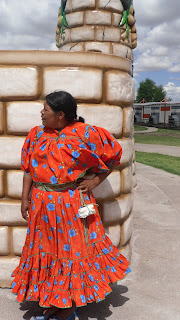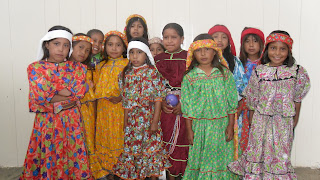The day after the Oasis graduation, the school sponsored a day trip to a water park just outsideof Chihuahua. Only the kindergarten and 6th graders were invited to attend, along with their parents and sponsors; the rest of the classes had smaller parties at places like McDonald's and KFC. Esperanza invited me to attend the day at the water park, and of course I went. Not only was I excited to go on yet another trip with the rarámuri (they are always fantastic bonding experiences, and I learn so much), I was really looking forward to a day at the pool. The average temperature in Chihuahua in the summer, just like El Paso, is about 100 degrees F. So it was a nice break to conduct my "field work" for a day at a pool rather than in the dusty settlement!
There is a small water park just before the Chihuahua city limits, with two large slides and three large swimming pools, including one for children. It is located in the middle of the desert, just off the highway that takes you to Ciudad Juárez. There are a few ranch houses and fields that grow cotton and alfalfa, and chains of mountains line the highway just miles away. It really is a small oasis in the middle of the desert: the pools are large and clean, the water is cool, and the view of mountains and open deserts just beyond the park is spectacular.

Jiovana and I wading in the childrens' pool
We had the park to ourselves. Three rarámuri mothers accompanied the group, along with six teachers. In total, we were about 25 people with the entire park to ourselves. That morning, I wasn't sure if I was going to swim, since I doubted the mothers would get into the pool; and if I did, I knew it would not be in my swimsuit, but in shorts and a t-shirt. The ráramuri are very modest and I would have felt extremely awkward wearing my swimsuit in front of them, even if they are all women. When we got to the pool, the mothers said they were not going to get in, just as I suspected. They stayed by the edge of the pool and watched the children play. I sat with them for a while, but after 15 minutes I couldn't withstand the temptation and I changed into shorts and a t-shirt and got into the pool with all the children. One of the jokes among the women is that I am a "teweke," or little girl, despite my 24 years. I initially earned this teasing nickname because I am 24 years old and and still husband-less and child-less, but over the course of the year I solidified the nickname by my behavior with the children--we run, play with toys, and even play-fight all the time. That day was no exception--I jumped straight into the pool and spent the day playing with the kids and screaming on my way down the water slides. After a while, a few of the teachers joined me, so I wasn't the only adult acting like a kid!

Rosa Angela's little boy had too much sun and fell asleep on the cool deck right before lunch.
It was such a treat to watch the rarámuri kids enjoy the pools. It is very rare that these children get to visit a park like this--most days, the children play in the arroyo behind Oasis, or on the street amidst all kinds of dangers: broken glass, speeding cars, drunks, drug addicts, and once in a while even a woman who comes around offering to buy rarámuri kids.
I think the mothers got a little bored sitting on the edge of the pool for almost eight hours. At one point they wandered to the back of the park and started filling plastic bags with weeds and grass. I knew immediately what they had found: guasoli, the edible herb that I sometimes accompany the women to search for in arroyos throughout the city. Some of the teachers were asking each other what the women were doing, and I was able to explain to them. It was
hilarious--trust the ráramuri to spot edible herbs in the unkept edges of the water park.
We were there until 6 PM, and I returned to my apartment with a glorious sunburn and feeling like a kid. It was a nice break from daily life for everyone who went.

There were three large pools for adults, one childrens' pool with games, and these two fantastic water slides. I must have gone down each of them about 20 times that day!

Esperanza and some of the teachers eating "carne asada" and "discada" for lunch.

The women didn't swim. Instead, they watched the children swim and chatted in the shade.


Jiovana wading in the childrens' pool.

In the afternoon, we returned to Oasis and told Julissa about our day. Her class went to KFC for their party earlier that day. The Kinder and 6th grade were given a bigger party because their graduations were greater milestones.







